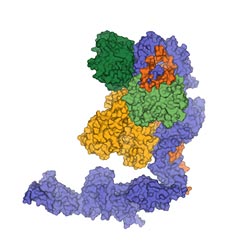Feeding RNAs to a molecular shredder

The ski complex plays an important role in the quality management of the cell.<br>Grafic: Felix Halbach © MPI of Biochemistry <br>
Scientists of the Max Planck Institute (MPI) of Biochemistry in Martinsried near Munich, Germany, have now decoded the structure of a protein complex (Ski complex) which plays an essential role in the process of degrading ribonucleic acids (RNAs).
“The Ski complex we investigated feeds RNA molecules to the degradation machinery,” says Felix Halbach, scientist at the MPI of Biochemistry. The study has now been published in the journal Cell.
RNAs are ubiquitous and abundant molecules with multiple functions in the cell, such as allowing the translation of the genomic information into proteins. Any errors that occur during the synthesis of RNA molecules or unwanted accumulation of RNAs can be harmful for the cell. The elimination of defective RNAs or of RNAs that are no longer needed is therefore a key step in the metabolism of a cell. This task is carried out by a protein complex called Exosome, one of the research objects in the department “Structural Cell Biology” headed by Elena Conti. The molecular mechanism of how the Exosome is regulated, however, is not very clear yet.
The Max Planck scientists have now elucidated the atomic structure and the operating mechanism of a protein complex (Ski complex) which is involved in the activation of the cytoplasmic Exosome. The Ski complex contains several subunits and can be found in all eukaryotes – from yeast to humans. “We could show that the Ski complex and the Exosome interact directly and that they jointly form a channel for the RNA which is supposed to be degraded,” says Felix Halbach. Like DNA, RNA molecules are often folded. To be degraded by the Exosome, RNA molecules have to be unfolded first – this task is executed by the Ski complex. The unfolded RNA molecules can then be guided through the joint channel to the Exosome. “The Ski complex feeds RNA molecules to the Exosome,” explains the biochemist.
The results also reveal additional parallels between the Exosome and the Proteasome. The Proteasome is the protein complex responsible for the degradation of proteins in a cell. “It becomes clear that these two complexes are not only structurally and functionally similar,” says Elena Conti, “also their regulatory subunits work in a similar manner.” They unwind RNA molecules or, respectively, proteins and guide them to the active centers of the specific degradation machinery.
Original Publication
Halbach, F., Reichelt, P., Rode, M. and Conti, E.: The yeast Ski complex: Crystal structure and substrate channeling to the RNA exosome. Cell, August 15, 2013
DOI: 10.1016/j.cell.2013.07.017
Contact
Prof. Dr. Elena Conti
Structural Cell Biology
Max Planck Institute of Biochemistry
Am Klopferspitz 18
82152 Martinsried
E-Mail: conti@biochem.mpg.de
http://www.biochem.mpg.de/conti
Anja Konschak
Public Relations
Max Planck Institute of Biochemistry
Am Klopferspitz 18
82152 Martinsried
Phone: +49 (0) 89 8578-2824
E-Mail: konschak@biochem.mpg.de
Weitere Informationen:
http://www.biochem.mpg.de/1857469/075_Conti_Ski
– Press Release
http://www.biochem.mpg.de/conti
– Website of the Research Department “Structural Biology” (Elena Conti)
Media Contact
More Information:
http://www.biochem.mpg.deAll latest news from the category: Life Sciences and Chemistry
Articles and reports from the Life Sciences and chemistry area deal with applied and basic research into modern biology, chemistry and human medicine.
Valuable information can be found on a range of life sciences fields including bacteriology, biochemistry, bionics, bioinformatics, biophysics, biotechnology, genetics, geobotany, human biology, marine biology, microbiology, molecular biology, cellular biology, zoology, bioinorganic chemistry, microchemistry and environmental chemistry.
Newest articles

High-energy-density aqueous battery based on halogen multi-electron transfer
Traditional non-aqueous lithium-ion batteries have a high energy density, but their safety is compromised due to the flammable organic electrolytes they utilize. Aqueous batteries use water as the solvent for…

First-ever combined heart pump and pig kidney transplant
…gives new hope to patient with terminal illness. Surgeons at NYU Langone Health performed the first-ever combined mechanical heart pump and gene-edited pig kidney transplant surgery in a 54-year-old woman…

Biophysics: Testing how well biomarkers work
LMU researchers have developed a method to determine how reliably target proteins can be labeled using super-resolution fluorescence microscopy. Modern microscopy techniques make it possible to examine the inner workings…





















